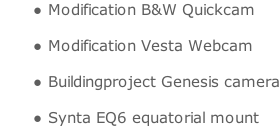



Copyright © All rights reserved. Made By Erik Bryssinck Terms of use | Privacy policy














|
Observation date |
image |
Photometry (FOCAS) |
astrometry |
Observatory |
|
|
X |
X |
|
X |
B96 - |
|
|
X |
X |
|
X |
B96 - |
|
|
|
|
|
|
|
|
|
|
|
|
|
|
|
|
|
|
|
|
|
|
|
|
|
|
|
|
|
|
|
|
|
|
|
|
|
|
|
|
|
|
|
Comet 28P/NEUJMIN
Photometric data obtained by use of FOCAS-
10x10 20x20 30x30 40x40 50x50 60x60 SNR SB COD
OBJECT DATE TIME +/-
-
28P 28/10/2021 00:02:52 17.11 17.13 17.14 17.09 16.86 16.49 9.5 18.1 B96
28P 28/10/2021 00:02:52* 0.02 0.10 0.07 0.11 0.25 0.20 3 4.0 Gai
AFRHO LOG
COMET UTC DELTA r BOX " MAG RSR CM +/-
-
28P 28/10/2021 00:02:52 2.23 2.96 12.37 17.20 10 55 6 1.742 B96
G. N. Neujmin (Simeis Observatory, Crimea, Ukraine) discovered this object on a photograph exposed on 1913 September 3.98, during a routine search for minor planets. The object was stellar and of magnitude 10.0. It was announced by Neujmin as a new minor planet. Kudrewisch (Pulkovo Observatory, Saint Petersburg, Russia) photographically confirmed the new object on September 5.91 and gave the magnitude as 10.8. On September 7, J. O. Backlund (Pulkovo Observatory) announced that Neujmin's minor planet was actually a comet, while K. Graff (Hamburg Observatory, Bergedorf, Germany) came to the same conclusion when he detected a short tail on September 7.10. The comet had passed perhihelion about 3 weeks prior its discovery and had passed closest to earth just over a day earlier. On sept. 8th, tha magnitude was given as 10.8-